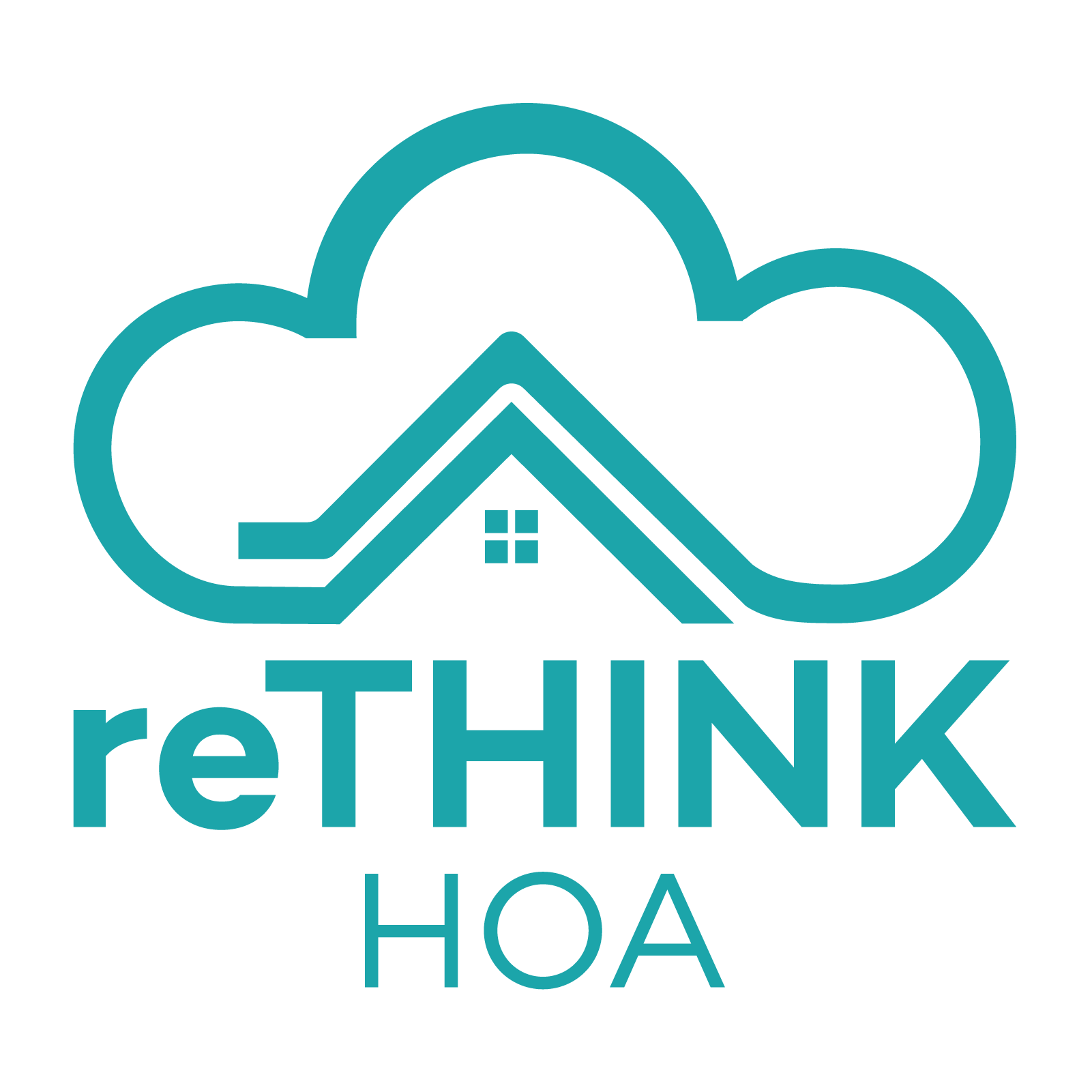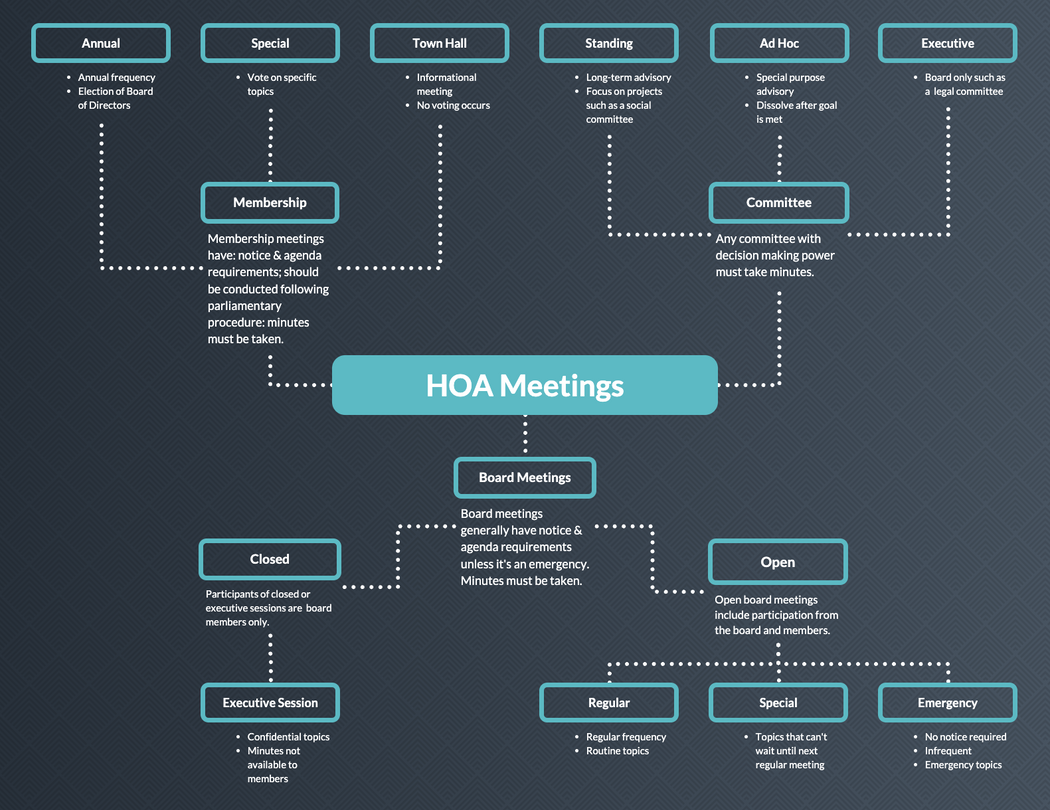As an HOA board member, conducting effective meetings is essential to ensure your community runs smoothly. This step-by-step guide will help you master the art of HOA board meetings and enable your community to thrive.

- Preparing for the Board Meeting: Creating an agenda is crucial for a well-organized HOA board meeting. Notify all board members and homeowners in advance, and follow state-specific notification requirements.
- Conducting the Board Meeting: Establish clear meeting rules and etiquette, such as following Robert's Rules of Order, to ensure a productive and respectful environment. Participants should understand their roles and responsibilities, and the meeting should stay on topic and encourage participation and communication.
- Wrapping Up the Board Meeting: Assign tasks and set deadlines before adjourning the meeting. Afterward, distribute approved meeting minutes to maintain transparency and monitor the progress of assigned tasks to ensure accountability.
- Seek continuous improvement: Solicit feedback from board members and homeowners to make each meeting more efficient and impactful, ultimately promoting the community's well-being.
Preparing for the Board Meeting
Creating an Agenda
Creating an agenda is the first step in preparing for an HOA board meeting. The agenda serves as the backbone of the meeting, outlining the discussion topics in the order in which the board plans to address them. Here are some tips for creating a comprehensive agenda:
- List all topics, including updates on ongoing projects, financial reports, and any new business or homeowner concerns.
- Organize the topics logically, following Robert's Rules of Order, starting with approving previous meeting minutes and ending with scheduling the next meeting.
- Allocate a specific time for each topic to keep the meeting on track and focused.
Notifying Board Members and Homeowners
After finalizing the agenda, inform all board members and homeowners about the upcoming meeting. Notifying members should be done well in advance to give everyone enough time to prepare. The board can notify its members by email, post on the community bulletin board, or distribute through other preferred communication channels such as a website.
Check your state's requirements and your HOA's bylaws for notification requirements.

California HOAs
For California HOAs, unless your HOA's bylaws require a more extended notice period, members should be notified of the meeting's time, place, and agenda at least four days before the meeting[1]. Executive session meetings require only a two-day notice[1]. Notice can be sent by individual delivery, such as inclusion in a billing statement, newsletter, or another document that is delivered, posted in a prominent location that is accessible to all members, or on a website accessible to all members[3].

Florida HOAs
HOAs in Florida must provide 48 hours posted notice except in an emergency[4].

Texas HOAs
In Texas, members of a property owners' association must be notified of board meetings containing the date, time, location, and subject of the meeting by mail or by posting notice either in the common area or electronically. Mail notifications must be given at least ten days before the meeting; Posted notifications must be given at least 144 hours before the regular board meeting and 72 hours before the start of a special board meeting. If a meeting is held over the phone, information on how to connect and listen must be provided in the notice[5].
Conducting the Board Meeting
Establishing Meeting Rules and Decorum
Before diving into the agenda, establish clear meeting rules and etiquette to ensure a productive and respectful environment. Conducting meetings following Robert's Rules of Order is the procedure of choice for most homeowners association meetings. Basic meeting etiquette may include the following:
- Starting and ending the meeting on time.
- Adhering to the agenda and avoiding side conversations.
- Allowing only one person to speak at a time and discouraging interruptions.

California HOAs
There is no requirement to follow Robert's Rules of Order or any other system of parliamentary procedure. Boards can use more flexible procedures unless the association's governing documents require otherwise. However, membership meetings must be conducted using a recognized system of parliamentary procedure[6].
Establishing Roles and Responsibilities
At an HOA board meeting, participants should clearly understand their roles and responsibilities to ensure a successful and productive session. The President, or chairperson, is responsible for leading the meeting and keeping discussions on track. The Vice President supports the president and may take over meeting leadership in their absence. The Secretary is responsible for taking detailed meeting minutes and documenting key decisions, actions, and discussions for future reference.
The Treasurer plays a vital role in providing financial updates and reports during the meeting, highlighting any areas of concern or areas for improvement. They are responsible for presenting the treasurer's report, which includes information about the association's budget, expenses, and overall financial health.
Committee reports are typically presented by the respective committee chairs or their designated representatives. These reports inform the board and homeowners about the progress and activities of various committees within the HOA, such as architectural review, landscaping, social events, and more.
Board members are expected to actively participate in discussions, contribute their expertise, and make informed decisions prioritizing the community's best interests. Although not involved in decision-making, homeowners should be allowed to voice their concerns and opinions during designated periods.
It is essential to refer to the HOA's governing documents for any other roles defined within your association. These documents may outline additional responsibilities or designate specific roles for other members or committees involved in the operation of the community.
Understanding and respecting these roles and responsibilities is crucial to maintaining order and ensuring the meeting achieves its objectives while promoting the community's well-being.
Following the Agenda and Staying on Topic
Sticking to the agenda is crucial to maintaining the meeting's focus and productivity. Board members should be mindful of time constraints and work together to stay on topic. If a new issue arises during the meeting, table it for discussion in a future meeting or handle it outside the meeting context.
Encouraging Participation and Communication
An effective board meeting is one where all members can voice their opinions and concerns. Encourage open communication and active listening to ensure everyone's thoughts are heard and considered.
Steps to Conducting a Board Meeting
- Call the meeting to order
- Approve the previous meeting's minutes
- Review and discuss each agenda item
- Allow for homeowner comments or concerns
- Vote on necessary actions or resolutions
- Schedule the next board meeting
- Adjourn the meeting
Wrapping Up the Board Meeting
Assigning Tasks and Setting Deadlines
Before adjourning the meeting, ensure that each task has the appropriate board member or committee assigned and has a deadline. Simply assigning the responsible party and setting a deadline helps keep everyone accountable and ensures the timely completion of tasks.
Post-Meeting Follow-Up
Distributing Meeting Minutes
Once the board approves the minutes, distribute them to all board members and homeowners. Distributing minutes keeps everyone informed of the board's decisions and provides transparency.

California HOAs
For California HOAs, open board minutes must be available to the membership within 30 days, and minutes must be permanently available for inspection. Member access to minutes must be granted within 15 calendar days following approval[2].
Monitoring Task Progress and Accountability
Regularly monitor the progress of assigned tasks and hold board members accountable for meeting their deadlines. Maintaining momentum ensures that the HOA is meeting the community's needs.
Tips for Conducting a Board Meeting
- Always have a written agenda to maintain focus and guide the meeting.
- Familiarize board members with Robert's Rules of Order or any specific meeting rules your HOA follows to promote order and fairness.
- Encourage open communication and establish clear boundaries to maintain respect and order.
- Stay organized and use technology, such as video conferencing or project management tools, to facilitate remote participation and streamline tasks.5. Seek continuous improvement by soliciting feedback from board members and homeowners after each meeting.
Final Thoughts
Effective HOA board meetings play a crucial role in the success of a self-managed community. By creating a well-organized agenda, encouraging open communication, and adhering to established rules and etiquette, you can create a productive and respectful meeting environment that promotes the well-being of your community. This step-by-step guide has provided insights into preparing for a board meeting, conducting the meeting, and following up post-meeting to ensure accountability and transparency. Continuously seek feedback and improvements to make each meeting more efficient and impactful. Remember, your leadership as a board member significantly influences your community members' overall success and satisfaction.
Footnotes & References
- California Legislative Information. Davis-Stirling §4920 Article 2. Board Meeting.
- California Legislative Information. Davis-Stirling 4040 Article 1. Preliminary Provisions.
- California Legislative Information. Davis-Stirling §5000 Article 3. Member Meetings.
- Florida Condo & HOA Law Blog. Condo/Co-Op/HOA Meeting Agendas & Notice Requirements.
(More stringent local provisions may apply) - Texas State Law Library. Property Owners Associations.
- California Legislative Information. Davis-Stirling §5000 Article 3. Member Meeting.
- Robert's Rules of Order - Official Site
Meeting Agenda Template and Robert's Rule of Order Reference Sheet
Sign up for our blog to receive a free meeting agenda template and Robert's Rules of Order reference sheet. With this handy reference, you'll be well-equipped to navigate and conduct effective HOA board meetings that benefit your entire community.
Sign-in or Subscribe to download the templates below! Comment if you have questions or suggestions.
This content is only available to subscribers
Subscribe now and have access to all our stories, enjoy exclusive content and stay up to date with constant updates.
Sign up nowAlready have an account? Sign in





